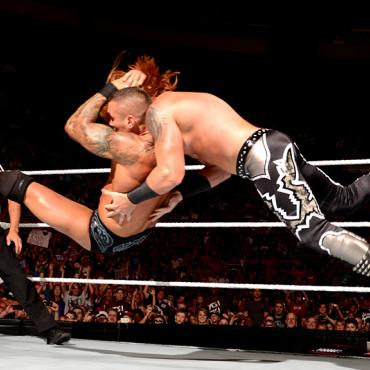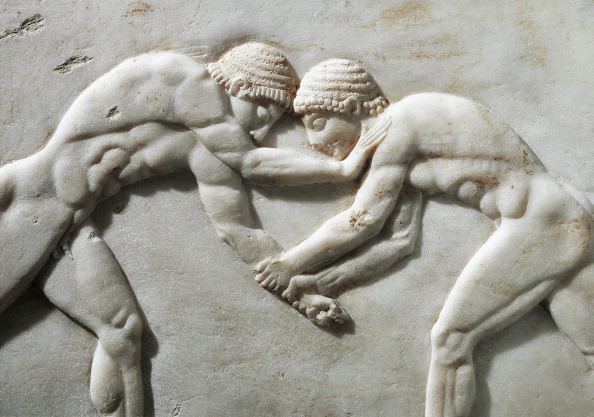When you think of wrestling, you may picture the glitz and glamour of WWE on TV, but wrestling is an actual Olympic sport. It is also rumoured to be the oldest sport known to mankind.

It is one of the purest forms of athletic competition to exist in the world of organized sports. There are no bats or balls. No pads or helmets. There's no time to rethink strategy, regroup, or even to catch your breath. There's only you, and your opponent of equal weight and size.
Experience, preparation and the will to succeed will determine the winner. There's no doubt that for me, wrestling tops the list of intense, highly-competitive sports.
Wrestling incorporates a unique balance of nearly all aspects of physical and psychological conditioning. Strength is as important as stamina; speed as important as technique; strategy as important as intensity; and power as important as coordination.
What is more, it’s not always the natural athlete that succeeds in the sport—it’s often the natural competitor.
Wrestling - an ancient and pure sport

Wrestling has roots in nearly every culture - it has a particularly solid foundation in ancient Greece long before the first recorded Olympic Games in 776 B.C.
Greek wrestling was an extremely popular form of competition. However, it had considerably undeveloped rules and was a much different style of wrestling than what is practiced on mats around the world today.
1904/5: Freestyle wrestling and the International Federation for Wrestling
Freestyle wrestling was introduced at the 1904 Olympic Games in St. Louis, Missouri. This new style of wrestling allowed wrestlers to incorporate pushing, lifting, tripping and other techniques using the lower body. Since the establishment of freestyle, both of the international styles have gained popularity and respect throughout the world, so much so that a universal governing body needed to be put in place to accommodate the growing needs of the wrestling community.
By the turn of the 20th century, wrestling had evolved from being an ancient art with various rules and styles, to becoming a major form of organized competition, recreation, and entertainment throughout the world.
In 1905, the first International Federation for Wrestling was created to unify and organize the different styles of the sport, especially the rapidly growing international style of freestyle.
FILA is born & the 2004 Olympics breaks records
The International Federation for Wrestling would go on to take many names, but in 1994, the world's governing body for wrestling would be given the name as we know it today - FILA (International Federation of Associated Wrestling Styles).
Today's professional form of wrestling was established in 2004. What followed was a historic landmark for all wrestlers, as another division based on gender was sanctioned as an Olympic event.
In 2015, the sport of wrestling has come a long way since it was practiced by our earliest ancestors. These days, traditional and modern forms of wrestling are practiced on every continent and in almost every country.
In particular, the 2004 Olympics reinforced wrestling's popularity for current generations, with over 344 competitors in both the freestyle and Greco-Roman divisions - this was a record number of competitors for an Olympic wrestling tournament.
The Rise of Women's Freestyle
(Molly Winstone aged 12 discusses her wrestling career to date.)
Although women have participated in the sport of wrestling for many years, organized women's divisions did not become present until the 1980s in European competition.
The rules in the women's divisions took on many forms and changed frequently at first. Over time, however, the same rules as male freestyle divisions were applied with very minor alterations. In 1984, FILA included women's freestyle wrestling in its association. Just a few years later, the first Women's World Championships were held in Lorenskog, Norway.
Women's wrestling has snowballed into a major force on the world level, fielding tough all-female teams from numerous countries.
Some of the best female wrestlers come from Azerbaijan, Japan, Canada, Ukraine, Russia and the United States. The establishment of the women's freestyle division at the 2004 Olympic Games in Athens refreshingly confirmed modern society's view of equality, and with it the definition of what an athlete truly is.
Wrestling with Tomorrow
As the world's wrestling community grows, the rules, techniques, and athletes continue to grow with it. The sport is changing rapidly meaning that one must truly be a student of wrestling to stay "in the know".
Female wrestlers in the United Kingdom are still strongly a minority compared to their male counterparts. Unfortunately. this means young female wrestlers are often facing the same competitors at different competitions, providing limited chance to progress.
Luckily, some like Molly are being pushed to develop by getting selected for regional and then National Talent Squads where they benefit from the wealth of knowledge from international coaches and good faculties.
By Steve Winstone

Steve Winstone is the father of English and British junior female wrestling champion Molly Winstone.
He was first introduced to the intense sport of free style wrestling through his son Jake who represented Great Britain before suffering a back injury. Jake decided to train as a level 2 coach and the Winstones decided to open their very own gym. They ran children’s wrestling classes and won 4 golds and 1 bronze mdel at their very first competition as a club (at the British Novice Wrestling Championship in Manchester).
Molly Winstone followed in the footsteps of her older sibling and won her first gold medal aged 12 at the British Novice Wrestling Championships. Find out more about Molly here.

